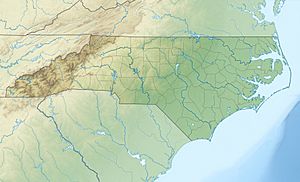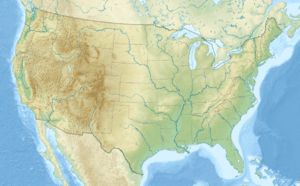Toms Creek (Uwharrie River tributary) facts for kids
Quick facts for kids Toms Creek |
|
|---|---|
|
Location of Toms Creek mouth
|
|
| Other name(s) | Tributary to Uwharrie River |
| Country | United States |
| State | North Carolina |
| County | Randolph |
| Physical characteristics | |
| Main source | Cabin Creek divide pond about 1.5 miles southeast of Denton, North Carolina 670 ft (200 m) 35°36′30″N 080°05′52″W / 35.60833°N 80.09778°W |
| River mouth | Uwharrie River about 2 miles southeast of Farmer, North Carolina 388 ft (118 m) 35°37′27″N 079°57′23″W / 35.62417°N 79.95639°W |
| Length | 12.51 mi (20.13 km) |
| Basin features | |
| Progression | northeast then southeast |
| River system | Pee Dee River |
| Basin size | 17.77 square miles (46.0 km2) |
| Tributaries |
|
| Bridges | Piedmont School Road, NC 47, Brantley Gordon Road, Richey Road, Old NC 49, NC 49 |
Toms Creek is a cool stream, about 12.51 mi (20.13 km) long. It flows through Randolph County, North Carolina. This creek is a "tributary," which means it's a smaller stream that flows into a bigger river. For Toms Creek, its water joins the Uwharrie River.
Other Names for Toms Creek
Did you know Toms Creek has been called by other names in the past? The Geographic Names Information System (which is like a big database of place names) shows it was once known as:
- Mill Creek
- Tom Creek
Where Toms Creek Flows
Toms Creek starts in a pond in Davidson County, North Carolina. This pond is about 1.5 miles (2.4 kilometers) southeast of a town called Denton, North Carolina.
From there, Toms Creek flows towards the northeast. It then enters Randolph County. After that, it makes a turn and flows southeast. Finally, it meets the Uwharrie River. This meeting point is about 2 miles (3.2 kilometers) southeast of Farmer, North Carolina.
The Toms Creek Watershed
A "watershed" is an area of land where all the water drains into a single river or stream. The Toms Creek watershed covers about 17.77 square miles (46.0 km2) (46 square kilometers).
This area gets a lot of rain, about 46.5 inches (118 centimeters) each year. A big part of the watershed, about 59%, is covered by forests. These forests help keep the water clean and healthy for the plants and animals living there.



